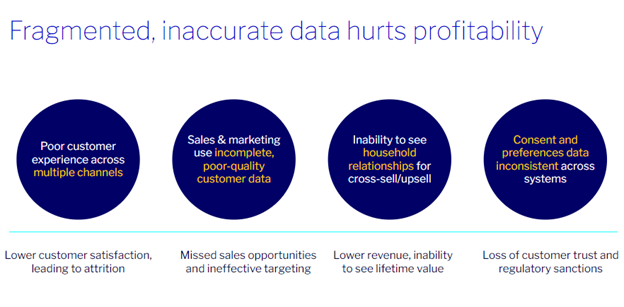
Most organizations are learning quickly that data is the main pillar of any transformation. That makes data management all the more important.
Despite fewer resources and smaller budgets, organizations continue doubling down on digital and data transformation initiatives. That’s because upstarts and disruptive technologies threaten established players in every industry. Barriers to entry are low with cheap and widely available technology and tools. The world became a digital-first place during the early days of COVID-19, and there’s no going back. Companies need to execute digital transformation or risk becoming irrelevant and do it faster as economic uncertainty and creative disruption test even the most established organizations.
Most organizations are learning quickly that data is the main pillar of any transformation, whether at a startup or a centuries-old institution. Data drives decision-making, shapes strategy, enhances customer experiences, and uncovers new revenue opportunities. The real-time availability of accurate, clean data in the cloud supports these key business outcomes. But despite having ample information, most organizations find it more difficult to rely on data to make informed decisions. A study by Oracle, for example, found that 95% of people are overwhelmed by data at work.
Any data-enabled evolution requires investment in the right mix of talent and technology. Both are changing dramatically, and the pace of change is speeding up. In today’s delicate economic climate, driving transformation means getting this combination right. Doing so drives a fundamental organizational shift from surviving to thriving.
See also: How to Bridge the Data Chasm and Unlock Digital Transformation
Today’s Data Leadership Requires a Blend of Business and Technical Skills
Gone are the days when data projects were stuffed in a company’s basement with bad lighting and second-hand desktop computers running spreadsheet applications. Leadership at most companies understands that leveraging data for transformation has become a do-or-die proposition. To ensure success in this resource-constrained environment, organizations need the right skillsets from the top down, including data advocates and expertise at the C-Level.
That’s why so many organizations have hired Chief Data Officers (CDOs) in recent years. In 2016, only about 6% of companies had a CDO. A recent survey found that 34% of North American public companies now have a CDO. CDOs are typically responsible for data governance, creating a company’s data culture while ensuring the enterprise maximizes the use of data as an asset. CDOs sit at the intersection of all business units, creating, improving, and analyzing data to move it out of silos, lakehouses, and warehouses and into the hands of data consumers. The CDO can drive the use of data to move quickly and rapidly deploy new data-driven applications that deliver a competitive advantage. A CDO can help the company take advantage of new technologies and trends in data management.
Historically, digital and cloud initiatives were seen as technology issues and the sole responsibility of the IT department. However, the growing importance of the CDO highlights the need for a more comprehensive approach to digital transformation that encompasses the right skills and business expertise across the organization. Today’s data professionals must have a blend of business and technical acumen from the C-level on down. Domain expertise is required to understand what type of data is needed by which teams and how it gets moved to the right places is crucial. Organizations often rely on their IT departments for key data initiatives without considering the business’s needs. Data has grown too large and complex to belong to a singular department in a large enterprise. Most IT departments, for example, probably don’t understand the modern sales process. However, they do understand where data is located, how it moves from storage to different systems, and the challenges of delivering that in a timely, accurate, and actionable manner.
In addition to CDOs, many other data-centric roles can bring technology and business acumen to the table. Having these roles and skillsets in-house is crucial for supporting an organization during a data transformation:
- Analysis – Understanding data structures, cleaning, and visualization techniques.
- Modeling – Creating conceptual and logical models.
- Governance – Implementing policies and procedures for data management, quality control, and security.
- Integration architecture – Designing data systems that meet the needs of an organization and align with its overall architecture.
- Compliance and Security – Protecting sensitive information from unauthorized access, theft, and breaches and overseeing privacy and sovereignty.
- Data science and analytics – Analyzing data to support informed decision-making, identify trends and patterns, and support strategic planning.
Unified, Clean, Enriched Data is the Key to Transformation
On the technology front, many organizations struggle to unify, cleanse, and enrich their core data to make it useful. Raw data on its own is useless; it needs to be stitched together from multiple sources, cleansed, and enriched to provide any useful insights or used for operational purposes. It also needs to happen in real time as data is never static. Data constantly changes, and failing to keep pace with these changes can negatively impact top-line growth and lead to missed opportunities.

Implementing a cloud-based core data unification solution, such as modern master data management (MDM) software, can greatly improve the effectiveness of enterprise data. MDM can dramatically reduce the time spent unifying and fixing any enterprise’s core data. Core data is information about customers, employees, products, or vendors and can reside in hundreds of applications or silos. Without a modern MDM tool, it’s almost impossible to unify, cleanse and make master data available to those who need it to run a business, make decisions, and uncover new revenue opportunities. Getting this right can unlock the keys to organizational transformation, shifting a company from surviving to thriving.
There are many business initiatives that MDM can help solve. Looking at the work done by some of our customers, we have seen many examples of cost savings, improved efficiencies, and new revenue opportunities. When reconciling data between its customer relationship management (CRM) and enterprise resource planning (ERP) systems, Schneider Electric identified customers they had mistakenly designated as inactive. By correcting them as active, Schneider added more focused marketing and sales opportunities to its pipeline, discovering several million dollars of potential opportunities it previously overlooked due to inaccurate data.
Dodge Construction Network provides data, information, and insights to its customers in the commercial construction industry. Through Reltio, Dodge gains a 360-degree view of customers, contacts, projects, and products, providing unparalleled data quality and the ability to bring new and enhanced services to market faster while experiencing a 30 percent increase in opportunities within its client base.
MDM improves the accuracy, completeness, and consistency of data in an organization. Implemented successfully, it leads to better decision-making and more aligned teams. Implementing MDM requires the right technology and technology-minded experts who possess business acumen. Understanding which internal and third-party tools are useful for which data consumers is a daunting task. For example, a business user may need to unify core data from first-party sources such as a billing system, a digital platform, a CRM tool, and a data lake. They may also add third-party enrichment tools such as a Dun & Bradstreet account to further enrich their internal data. Connecting all of these systems to create a single version of the truth can significantly improve data quality for any organization. Doing so enables a seamless customer experience that accelerates growth and operational excellence, improves efficiency, simplifies risk management and compliance, and reduces potential losses and regulatory fines.
Leveraging Technology and Business Expertise to Unleash Data Transformation
Data is a transformative asset in a cost-saving business environment that can help organizations make informed decisions, reduce operational costs, and improve efficiency. It can track spending, identify inefficiencies, optimize processes, and provide insights into customer behavior and preferences, leading to targeted and cost-effective marketing and sales efforts. By leveraging data and analytics, organizations can reduce costs, improve their bottom line, and enhance the customer experience.
Solving data challenges is not simply a technology or people problem – it’s both. Companies are undergoing rapid transformations to achieve various objectives, requiring a shift towards becoming digital-first in all aspects. To successfully carry out these transformations and drive business value, it is crucial to have high-quality, unified, and trusted data on customers, accounts, vendors, and assets.




























